Stefan M. Kostka (born 1939) [1] is an American music theorist, author, and Professor Emeritus of music theory at the University of Texas at Austin. [2]
Stefan M. Kostka (born 1939) [1] is an American music theorist, author, and Professor Emeritus of music theory at the University of Texas at Austin. [2]
Kostka graduated from the University of Colorado with a Bachelor's Degree, and then received a graduate degree at the University of Texas, studying under Kent Kennan before receiving a PhD in music theory from the University of Wisconsin. [3]
He was a member of the faculty of the Eastman School of Music from 1969 to 1973, and since that time has been on the faculty at the University Texas at Austin. Kostka initiated courses in computer applications in music at both the Eastman School and the University of Texas. Later, he specialized in courses in atonal theory and contemporary styles and techniques.
In music, the tonic is the first scale degree of the diatonic scale and the tonal center or final resolution tone that is commonly used in the final cadence in tonal classical music, popular music, and traditional music. In the movable do solfège system, the tonic note is sung as do. More generally, the tonic is the note upon which all other notes of a piece are hierarchically referenced. Scales are named after their tonics: for instance, the tonic of the C major scale is the note C.

Atonality in its broadest sense is music that lacks a tonal center, or key. Atonality, in this sense, usually describes compositions written from about the early 20th-century to the present day, where a hierarchy of harmonies focusing on a single, central triad is not used, and the notes of the chromatic scale function independently of one another. More narrowly, the term atonality describes music that does not conform to the system of tonal hierarchies that characterized European classical music between the seventeenth and nineteenth centuries. "The repertory of atonal music is characterized by the occurrence of pitches in novel combinations, as well as by the occurrence of familiar pitch combinations in unfamiliar environments".
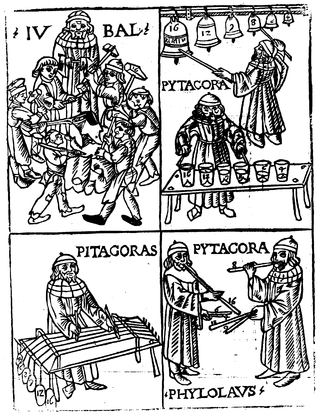
Music theory is the study of the practices and possibilities of music. The Oxford Companion to Music describes three interrelated uses of the term "music theory": The first is the "rudiments", that are needed to understand music notation ; the second is learning scholars' views on music from antiquity to the present; the third is a sub-topic of musicology that "seeks to define processes and general principles in music". The musicological approach to theory differs from music analysis "in that it takes as its starting-point not the individual work or performance but the fundamental materials from which it is built."
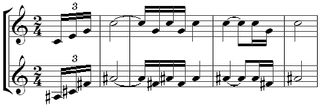
Polytonality is the musical use of more than one key simultaneously. Bitonality is the use of only two different keys at the same time. Polyvalence or polyvalency is the use of more than one harmonic function, from the same key, at the same time.
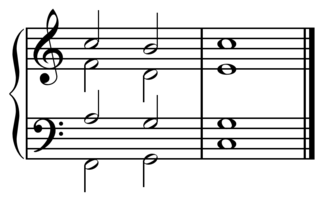
Tonality is the arrangement of pitches and/or chords of a musical work in a hierarchy of perceived relations, stabilities, attractions, and directionality. In this hierarchy the single pitch or triad with the greatest stability is called the tonic. The root of the tonic triad forms the name given to the key, so in the key of C major the tone C can be both the tonic of the scale and the root of the tonic triad. The tonic can be a different tone in the same scale, when the work is said to be in one of the modes of the scale.
In music, form refers to the structure of a musical composition or performance. In his book, Worlds of Music, Jeff Todd Titon suggests that a number of organizational elements may determine the formal structure of a piece of music, such as "the arrangement of musical units of rhythm, melody, and/or harmony that show repetition or variation, the arrangement of the instruments, or the way a symphonic piece is orchestrated", among other factors. It is, "the ways in which a composition is shaped to create a meaningful musical experience for the listener."
"Form refers to the largest shape of the composition. Form in music is the result of the interaction of the four structural elements described above [sound, harmony, melody, rhythm]."
In music theory, an augmented sixth chord contains the interval of an augmented sixth, usually above its bass tone. This chord has its origins in the Renaissance, was further developed in the Baroque, and became a distinctive part of the musical style of the Classical and Romantic periods.
In music, the subtonic is the degree of a musical scale which is a whole step below the tonic note. In a major key, it is a lowered, or flattened, seventh scale degree. It appears as the seventh scale degree in the natural minor and descending melodic minor scales but not in the major scale. In major keys, the subtonic sometimes appears in borrowed chords. In the movable do solfège system, the subtonic note is sung as te.

In music and music theory, a polychord consists of two or more chords, one on top of the other. In shorthand they are written with the top chord above a line and the bottom chord below, for example F upon C: F/C.
A movement is a self-contained part of a musical composition or musical form. While individual or selected movements from a composition are sometimes performed separately as stand-alone pieces, a performance of the complete work requires all the movements to be performed in succession. A movement is a section, "a major structural unit perceived as the result of the coincidence of relatively large numbers of structural phenomena".
A unit of a larger work that may stand by itself as a complete composition. Such divisions are usually self-contained. Most often the sequence of movements is arranged fast-slow-fast or in some other order that provides contrast.
While the ultimate harmonic goal of a tonal composition is the final tonic triad, there will also be many interior harmonic goals found within the piece, some of them tonic triads and some of them not. ...We use the term cadence to mean a harmonic goal, specifically the chords used at the goal.
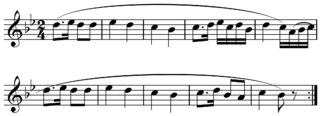
In music theory, a phrase is a unit of musical meter that has a complete musical sense of its own, built from figures, motifs, and cells, and combining to form melodies, periods and larger sections.
A phrase is a substantial musical thought, which ends with a musical punctuation called a cadence. Phrases are created in music through an interaction of melody, harmony, and rhythm.
In music, quartal harmony is the building of harmonic structures built from the intervals of the perfect fourth, the augmented fourth and the diminished fourth. For instance, a three-note quartal chord on C can be built by stacking perfect fourths, C–F–B♭.
Voice leading is the linear progression of individual melodic lines and their interaction with one another to create harmonies, typically in accordance with the principles of common-practice harmony and counterpoint.
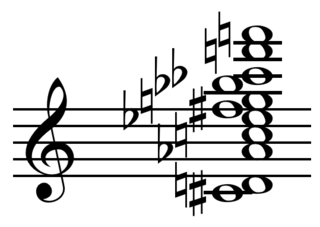
In musical composition, a sound mass or sound collective is the result of compositional techniques, in which, "the importance of individual pitches", is minimized, "in preference for texture, timbre, and dynamics as primary shapers of gesture and impact", obscuring, "the boundary between sound and noise".
The omnibus progression in music is a chord progression characterized by chromatic lines moving in opposite directions. The progression has its origins in the various Baroque harmonizations of the descending chromatic fourth in the bass ostinato pattern of passacaglia, known as the "lament bass". However, in its fullest form the omnibus progression involves a descent in the bass which traverses a whole octave and includes every note of the chromatic scale. It may also include one or more chromatic ascending tetrachords in the soprano, tenor and alto.

Drei Klavierstücke, Op. 11, is a set of pieces for solo piano written by the Austrian composer Arnold Schoenberg in 1909. They represent an early example of atonality in the composer's work.
The augmented seventh chord, or seventh augmented fifth chord, or seventh sharp five chord is a seventh chord composed of a root, major third, augmented fifth, and minor seventh. It can be viewed as an augmented triad with a minor seventh. When using popular-music symbols, it is denoted by +7, aug7, or 7♯5. For example, the augmented seventh chord built on A♭, written as A♭+7, has pitches A♭-C-E-G♭:
In music, the dominant is the fifth scale degree of the diatonic scale. It is called the dominant because it is second in importance to the first scale degree, the tonic. In the movable do solfège system, the dominant note is sung as "So(l)".

In music, the third factor of a chord is the note or pitch two scale degrees above the root or tonal center. When the third is the bass note, or lowest note, of the expressed triad, the chord is in first inversion.